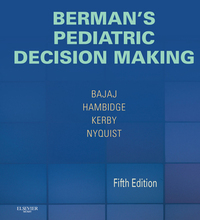「重要なお知らせ:日本語書籍をご購入いただき、eLibraryをご利用の皆さまへ」
エルゼビアは、より快適にサービスをご利用いただくため、システムの重要なアップデートを実施いたします。
現在、新サイト、eBooks+への移行が進められています。
新規ユーザー登録および書籍の登録はElsevier eLibraryでは停止しております。
12月15日以降に
こちらよりご利用・ご登録ください。
Book Description
Berman’s Pediatric Decision Making uses an algorithmic, structured approach to lead you to the right diagnosis and treatment every time. Drs. Lalit Baja, Simon Hambidge, Ann-Christine Nyquist, and Gwendolyn Kerby use evidence-based research and flow charts for each presenting complaint or specific disorder to provide quick access to the information you need for effective decision making. With updated drug tables and revised algorithms, this streamlined new edition makes it even easier for you to diagnose and manage common clinical problems from infancy through adolescence.
- Rapidly access guidance on diagnosis and management from algorithms for each clinical disorder.
- Treat the full range of diseases and disorders with comprehensive coverage of diagnosis, assessment of severity, and clinical management.
Choose the best treatment for each case thanks to indications for surgical interventions as well as expensive diagnostic procedures
- Stay current on recent developments and make effective decisions for movement disorders, physical abuse in children, sexual abuse in children, eating disorders, ADHD, and other hot topics.
- Find answers quickly and easily with a new table of contents organized into two sections—Presenting Complaints and Specific Disorders—that reduces the need to flip between chapters.
- Tap into the diverse perspectives of expert authors from all over the country.
- Get only the information you need in the streamlined new edition with shorter, more user-friendly flow diagrams and fewer specialized chapters.


 (0 rating)
(0 rating) 




